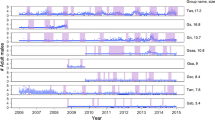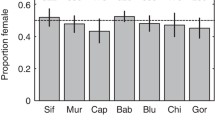Summary
The effect of variation in group size on age-specific survivorship and fecundity rates were examined in a population of wedge-capped capuchin monkeys Cebus olivaceus during a 10 year study. Life tables were constructed separately for four large (≥15 individuals) and four small groups (<15 individuals). Female reproductive success, and its relative contribution to population growth, was much higher in large groups, primarily through higher age-specific fecundity. Age-specific survivorship was similar in groups of different sizes. The reproductive success of the single breeding male in a group was much higher in large than small groups. Compared to small groups, breeding males in large groups had a longer breeding tenure, and access to greater numbers of reproductive females with a higher average fecundity. Differences in female reproductive success apparently resulted from variation in access to monopolizable fruit trees. Large groups predictably displaced small groups during intergroup encounters. Group rank depended on the number of males resident in groups. The large number of non-breeding males in large groups results from their longer average residency time. I explain the longer residency of males in large groups by the higher average reproductive success of breeding males in these groups.
Similar content being viewed by others
References
Alexander RD (1974) The evolution of social behavior. Ann Rev Ecol Syst 5:325–383
Alexander RD, Tinkle DW (1981) Natural selection and social behavior. Recent research and new theory. Chiron Press, New York
Altmann SA (1974) Baboons, space, time, and energy. Am Zool 14:221–248
Bateman AJ (1948) Intra-sexual selection in Drosophila. Heredity 2:349–368
Bradbury JW, Vehrencamp SL (1977) Social organization and foraging in emballonurid bats. Behav Ecol Sociobiol 2:1–17
Calhoun JB (1963) The social use of space. In: Mayer WV, van Gelder RG (eds) Physiological mammalogy, vol 1. Academic Press, New York, pp 1–187
Caughley G (1977) Analysis of vertebrate populations. Wiley, London
Carpenter CR (1942) Societies of monkeys and apes. Biol Symp 8:177–204
Chapman M, Hausfater G (1979) The reproductive consequences of infanticide in langurs: a mathematical model. Behav Ecol Sociobiol 5:227–240
Cheney DL (1987) Interactions and relationships between groups. In: Smuts BB, Cheney DL, Seyfarth RM, Wrangham RW, Struhsaker TT (eds) Primate societies. University of Chicago Press, Chicago, pp 267–281
Cheney DL, Wrangham RW (1987) Predation. In: Smuts BB, Cheney DL, Seyfarth RM, Wrangham RW, Struhsaker TT (eds) Primate societies. University of Chicago Press, Chicago, pp 267–281
Clutton-Brock TH (1977) Some aspects of intraspecific variation in feeding and ranging behaviour in primates. In: Clutton-Brock TH (ed) Primate ecology. Academic Press, New York, pp 539–556
Clutton-Brock TH, Guinness FE, Albon SD (1982) Red deer. Behaviour and ecology of two sexes. University of Chicago Press, Chicago
Clutton-Brock TH, Harvey PH (1977) Primate ecology and social organization. J Zool (London) 183:1–39
Crook JH, Aldrich-Blake FPG (1968) Ecological and behavioural contrasts between sympatric ground-dwelling primates in Ethiopia. Folia Primatol 8:192–227
Crook JH, Gartlan JS (1966) Evolution of primate societies. Nature 210:1200–1203
DeVore I, Hall KRL (1965) Baboon ecology. In: DeVore I (ed) Primate behavior. Holt, Rinehart & Winston, New York, pp 20–52
Dunbar RIM (1987) Demography and reproduction. In: Smuts BB, Cheney DL, Seyfarth RM, Wrangham RW, Struhsaker TT (eds) Primate societies. University of Chicago Press, Chicago, pp 240–249
Dunbar RIM, Nathan MF (1972) Social organization of the Guinea baboon. Folia Primatol 17:321–334
Eisenberg JF, Muckenhirn NA, Rudran R (1972) The relation between ecology and social structure in primates. Science 176:863–874
Emlen ST, Oring LW (1977) Ecology, sexual selection, and the evolution of mating systems. Science 197:215–223
Gartlan JS, Brain CK (1968) Ecology and social variability in Cercopithecus aethiops and C. mitis. In: Jay P (ed) Primates: Studies in adaptation and variability. Holt, Rinehart & Winston, New York, pp 253–292
Green S (1978) Feeding, spacing, and movements as correlates of group size in the lion-tailed macaque. In: Chivers DJ, Herbert J (eds) Recent advances in primatology, vol 1. Academic Press, New York, pp 343–345
Haddow AJ (1952) Field studies of the African redtail monkey: the composition, size and behaviour of bands. Proc Zool Soc Lond 122:297–394, Part II
Harpending H (1976) Regional variation in !Kung populations. In: Lee RB, DeVore I (eds) Kalahari Hunter-Gatherers. Studies of the !Kung San and their neighbors. Harvard University Press, Cambridge, pp 152–165
Hrdy SB (1974) Male-male competition and infanticide among langurs (Presbytis entellus) of Abu, Rajasthan. Folia Primatol 22:19–58
Janson C (1986) Direct and indirect competition for food in brown capuchin monkeys. Primate Report 14:13
Lotka AJ (1907) Relationship between birth rates and death rates. Science 26:21–22
Mantel N (1966) Evaluation of survival data and two new rank order statistics arising in its consideration. Cancer Chemother Rep 50:163–170
Mori A (1979) Analysis of population changes by measurement of body weight in the Koshima troop of Japanese monkeys. Primates 20:371–397
Petrie M (1983) Female moorhens compete for small fat males. Science 220:413–414
Robinson JG (1981) Spatial structure in foraging groups of wedge-capped capuchin monkeys Cebus nigrivittatus. Anim Behav 29:1036–1056
Robinson JG (1986) Seasonal variation in use of time and space by the wedge-capped capuchin monkey Cebus olivaceus: Implications for foraging theory. Smiths Contribs Zool 431:1–60
Robinson JG (1988) Demography and group structure in wedge-capped capuchin monkeys Cebus olivaceus. Behaviour 104:202–232
Robinson JG, Janson CH (1987) Capuchins, squirrel monkeys and atelines: socioecological convergence. In: Smuts BB, Cheney DL, Seyfarth RM, Wrangham RW, Struhsaker TT (eds) Primate societies. University of Chicago Press, Chicago, pp 69–82
Ruiter JR de (1986) The influence of group size on predator scanning and foraging behaviour of wedge-capped capuchin monkeys (Cebus olivaceus). Behaviour 98:240–258
Sadleir RMS (1969) Ecology of reproduction in wild and domestic mammals. Methuen, London
Schaik CP van (1983) Why are diurnal primates living in groups? Behaviour 87:120–144
Schaik CP van, Noordwijk MA van, Boer RJ de, Tonkelaar I den (1983a) The effect of group size on time budgets and social behaviour in wild long-tailed macaques (Macaca fascicularis). Behav Ecol Sociobiol 13:173–181
Schaik CP van, Warsono B, Sutriono E (1983b) Party size and early detection of predators in Sumatra forest primates. Primates 24:211–221
Snedecor GW, Cochran WG (1974) Statistical methods. Iowa State University Press, SPSS Ames, Iowa (1986) SPSSx User's Guide, 2nd edn. SPSS Inc, Chicago
Srikosamatara S (1987) Group size in wedge-capped capuchin monkeys (Cebus olivaceus): Vulnerability to predators, intragroup and intergroup feeding competition. PhD Dissertation, University of Florida, Gainesville
Stacey PB (1986) Group size and foraging efficiency in yellow baboons. Behav Ecol Sociobiol 18:175–187
Sugiyama Y (1967) Social organization of Hanuman langurs. In: Altmann SA (ed) Social communication among primates. University of Chicago Press, Chicago, pp 221–236
Terborgh J (1983) Five new world primates: A study in comparative ecology. Princeton University Press, Princeton
Waser PM (1977) Feeding, ranging, and group size in the mangabey Cercocebus albigena. In: Clutton-Brock TH (ed) Primate ecology. Academic Press, New York, pp 183–222
Waser PM, Wiley RH (1979) Mechanisms and evolution of spacing in animals. In: Marler P, Vandenbergh JG (eds) Handbook of behavioral neurobiology. Vol 3: Social behavior and communication. Plenum Press, New York, pp 159–223
Wrangham RW (1980) An ecological model of female-bonded primate groups. Behaviour 75:262–300
Wrangham RW (1987) Evolution of social structure. In: Smuts BB, Cheney DL, Seyfarth RM, Wrangham RW, Struhsaker TT (eds) Primate societies. University of Chicago Press, Chicago, pp 289–296
Zuckerman S (1932) The social life of monkeys and apes. Routledge and Kegan Paul, London
Author information
Authors and Affiliations
Rights and permissions
About this article
Cite this article
Robinson, J.G. Group size in wedge-capped capuchin monkeys Cebus olivaceus and the reproductive success of males and females. Behav Ecol Sociobiol 23, 187–197 (1988). https://doi.org/10.1007/BF00300353
Received:
Accepted:
Issue Date:
DOI: https://doi.org/10.1007/BF00300353




